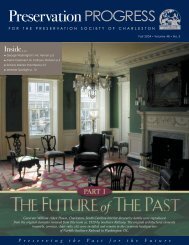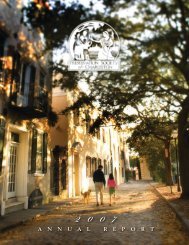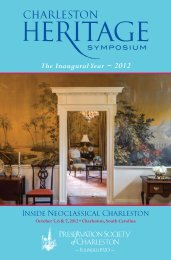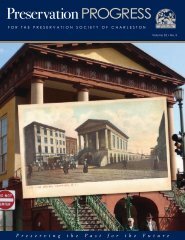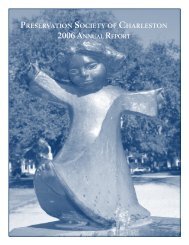download pdf - Preservation Society of Charleston
download pdf - Preservation Society of Charleston
download pdf - Preservation Society of Charleston
- No tags were found...
You also want an ePaper? Increase the reach of your titles
YUMPU automatically turns print PDFs into web optimized ePapers that Google loves.
<strong>Preservation</strong> PROGRESS 15<br />
Foundation” and successfully interceded by buying the property and selling<br />
it to a more sympathetic developer. The efforts <strong>of</strong> this group were frustrated<br />
by the city’s lack <strong>of</strong> accurate documentation on some <strong>of</strong> the buildings at risk<br />
– rendering legally powerless most <strong>of</strong> the preservation safeguards in place at<br />
the time. While the end result turned out to be the infinitely more acceptable<br />
low-rise Lodge Alley complex we know today, the difficult process fostered an<br />
invaluable byproduct. It inspired the first in-depth, pr<strong>of</strong>essional inventory <strong>of</strong><br />
<strong>Charleston</strong>’s existing architectural heritage since the Carolina Art Association<br />
published their survey called This is <strong>Charleston</strong><br />
in 1944.<br />
In 1972, the <strong>Society</strong> had received an <strong>of</strong>fer<br />
from a private individual to buy the Lining<br />
House. After serious debate among the membership<br />
(ending with covenants accepted by<br />
the new owner to ensure its continuing preservation),<br />
the house was sold. This transaction<br />
left the <strong>Society</strong> (temporarily) in better financial<br />
situation than in its entire history to date.<br />
In 1974, the <strong>Society</strong> undertook the moving<br />
<strong>of</strong> six houses which were on the site <strong>of</strong><br />
a municipal parking garage being built on<br />
the corner <strong>of</strong> George and St. Philip Streets.<br />
<strong>Preservation</strong> Progress called this project the<br />
largest house-moving in the history <strong>of</strong> the<br />
city. Another fundraising effort launched in<br />
<strong>Preservation</strong> Progress was to save the Frederick<br />
Wolfe House at 21 State Street (c.1796), a rare<br />
example <strong>of</strong> a “middle class” <strong>Charleston</strong> dwelling<br />
that was about to become a bank’s parking<br />
lot. This house, too, was successfully moved,<br />
restored, and then sold.<br />
The obligation to raise “rescue” funds<br />
for what seemed like an endless list <strong>of</strong> endangered<br />
structures was an ever-present strain<br />
on the <strong>Society</strong>. Realizing that these needs far<br />
outpaced the <strong>Society</strong>’s economic resources, the <strong>Society</strong>’s focus shifted from<br />
bricks and mortar projects to advocacy.<br />
Some financial relief came with the publication <strong>of</strong> <strong>Charleston</strong> Houses and<br />
Gardens, (Legacy Publications, 1976). This handsome c<strong>of</strong>fee-table book with<br />
photos by Jane Iseley and text by Evangeline Davis, took two years to produce<br />
and was a major source <strong>of</strong> income to the organization. It was followed in 1979<br />
by <strong>Charleston</strong> Interiors, (this time the text was by Henry F. Cauthen).<br />
In anticipation <strong>of</strong> additional tourism generated by America’s Bicentennial<br />
celebration, <strong>Preservation</strong> Progress reported to the membership in 1976 that fall<br />
(fundraising) house tours would resume. According to the <strong>Society</strong>’s archives,<br />
house tours were held prior to 1934, but they had been suspended as being<br />
“too costly” during the difficult Depression years. In the meanwhile, Historic<br />
<strong>Charleston</strong> Foundation’s spring tours had become quite popular and an<br />
autumn version was deemed a viable income source for the <strong>Society</strong>. The Fall<br />
Candlelight Tours <strong>of</strong> Homes and Gardens became a <strong>Society</strong>-sponsored event<br />
that endures to this day.<br />
In March 1977, the first article in <strong>Preservation</strong> Progress appeared in which<br />
the city’s assistant planner discussed initial ideas for revitalizing the city’s<br />
King Street business corridor. This was the opening volley for what would<br />
become an epic conflict for the <strong>Society</strong>. The early plans included the building<br />
<strong>of</strong> a massive convention complex including a hotel and parking garage to go up<br />
in the block between King and Meeting Streets. From this point forward, the<br />
battle was on to keep the scale <strong>of</strong> these plans from overwhelming the historic<br />
cityscape. Eventually, the conflict became a legal struggle entangling preservation<br />
ethics, business interests, and even personalities. Although it was a<br />
very difficult, stressful time for everyone associated with the <strong>Society</strong>, the end<br />
result was a greatly scaled-down project (and a preserved facade on Meeting<br />
Street that time has redeemed as being very worthwhile) and the more-reasonably<br />
scaled facility now called <strong>Charleston</strong> Place.<br />
During the 1980s, while the tools <strong>of</strong> preservation were becoming more<br />
political and technically sophisticated, another quiet revolution was taking<br />
place. The popularity <strong>of</strong> personal computers both at home and in the workplace<br />
spawned the widespread use <strong>of</strong> desktop publishing. Suddenly the standards<br />
were raised for all printed material and especially for newsletters like<br />
<strong>Preservation</strong> Progress. Some felt the “grass roots” look fostered by the <strong>Society</strong><br />
for years held a certain charm and appropriateness, while others saw the need<br />
to join the parade <strong>of</strong> progress and accurately reflect our organization’s modernity.<br />
In 1982, the first pr<strong>of</strong>essionally typeset<br />
<strong>Preservation</strong> Progress rolled <strong>of</strong>f the press. It was<br />
a small change technically, but it opened the<br />
doors to a new world <strong>of</strong> layout and graphic<br />
options – not the least <strong>of</strong> which was greater<br />
readability for <strong>Society</strong> members and friends.<br />
In 1982, the <strong>Preservation</strong> <strong>Society</strong> accepted<br />
its first conservation easement – a legal guarantee<br />
that a property will never be unsympathetically<br />
developed or altered in appearance.<br />
Donating an easement to the <strong>Society</strong> gave the<br />
donor a one-time tax deduction that became<br />
a new and popular tool <strong>of</strong> preservation. By<br />
1985, the <strong>Society</strong> had received more than<br />
thirty easements for homes, condominiums,<br />
hotels, inns, retail stores, warehouses, and<br />
restaurants.<br />
Readers <strong>of</strong> <strong>Preservation</strong> Progress during the<br />
1980s followed the design refinement <strong>of</strong> the<br />
courthouse annex just <strong>of</strong>f the Four Corners <strong>of</strong><br />
Law, the restoration <strong>of</strong> the Exchange Building,<br />
a renaissance <strong>of</strong> Hampton Park, the development<br />
<strong>of</strong> the city’s new Waterfront Park along<br />
the Cooper River, and the adaptive reuse<br />
<strong>of</strong> an old railroad shed as the city’s Visitor<br />
Reception and Transportation Center.<br />
Also during the 1980s, <strong>Preservation</strong><br />
Progress took the opportunity to revisit the last <strong>of</strong> the <strong>Society</strong>’s founding<br />
generation – introducing these remarkable individuals to new members<br />
and saluting their achievements. Alston Deas, Dorothy Porcher Legge, Jack<br />
Krawcheck, and John D. Muller, Jr. were among those pioneer <strong>Charleston</strong><br />
preservationists pr<strong>of</strong>iled in our pages. Although they are no longer with us,<br />
their memories live on through their pr<strong>of</strong>iles, which continue to inspire.<br />
As everyone knows, a hurricane named “Hugo” punctuated the end <strong>of</strong><br />
the 1980s. No one here at the time will ever forget it. The <strong>Society</strong>’s new<br />
executive director John W. Meffert had only been on the job 15 months when<br />
Hugo struck. It must have seemed as if the <strong>Society</strong>’s total effort – the preservation<br />
work <strong>of</strong> more than half a century – was undone in one horrible night.<br />
<strong>Preservation</strong> Progress was clearly staggered by the storm, but not silenced. It<br />
flickered, faltered, and regressed back to a typewritten, 12- page format. But<br />
under his leadership it heroically went to press less than three weeks after the<br />
storm listing important recovery resources and encouraging patience as the<br />
clean-up and restoration process slowly began. It reassured the membership<br />
<strong>of</strong> the <strong>Preservation</strong> <strong>Society</strong> <strong>of</strong> <strong>Charleston</strong> that we will endure, come hell or<br />
high water. And we did. The following issue <strong>of</strong> <strong>Preservation</strong> Progress published<br />
in December 1989–slightly over a month later – featured an adaptation<br />
<strong>of</strong> the Carolopolis seal ravaged by flood waters and strewn with hurricane<br />
debris. “Once again,” it said, “the endurance <strong>of</strong> her timeless courage shall<br />
triumph over adversity to mend and preserve the treasures <strong>of</strong> her heritage for<br />
future generations. This is <strong>Charleston</strong> 1989.” ■<br />
NEXT ISSUE:<br />
Part III, From the 1990s into the Future.



